|
Scribe Weekly |
|
|
Dedications for Scribe Weekly Radio
|
The Moray Coast By Steve Boyle If youíre looking for a holiday location that offers long sandy beaches, historic castles and battlefields, walking and climbing and great visitor attractions then the Moray coast is just what youíre looking for.The Moray coast runs eastwards from Inverness. There is a wide variety of accommodation to suit every budget and taste. Sitting in the shadow of the Cairn Gorms the weather is often warm and dry. The area was known as the Rivera of the north because of its mild summer climate. We stayed on a cottage on a family run mixed farm on the edge of the Cawdor estate near Auldearn which is a couple of miles east of Nairn. Details here The cottage was well fitted out and as described in the brochure. There were a couple of 2 mile walks around the farm which made for a pleasant evening stroll. The farmer himself offered a guided tour of the farm and answered questions. Cardhu Distilery There really is a lot to do in the area and no visit would be complete without a visit to a distillery and there are many to choose from. The Macallan has long been my favourite single malt and so we headed through Elgin and inland to Craigelachie sadly although the visitor centre was open the tour was not available as they were in their ďsix week quiet periodĒ when no distilling takes place. Our fault not theirs we should have phoned ahead. There was a video to watch and staff were on hand to answer any questions. Visitors were also invited to sample the product which of course we did. So we set of in search of another distillery to tour and stumbled across the Carhduh at Knockando. Cardhu is the malt at the heart of the Johnnie Walker blends. And like JW is owned by drinks giant Diageo. Globalization can be seen here on Speyside as very few family run distilleries remain. One of the first surprises was that the tour is not free as traditionally they had been in the past. One gets the distinct impression that the men in grey suits have been busy. Having said that the £4.00 fee only applies to adults over the UK drinking age of 18 and children are welcome on the tour. Your Ticket does entitle you to a £3.00 discount off a bottle in the shop. The young lady who conducted the tour was knowledgeable about the process and was able to answer our questions. As you move from process to process you may notice that there are very few people to be seen. We actually only saw one worker in the whole building. The reason is that at any one time the whole process can be run by one person. Such is the level of automation that only about seven staff are required to run a 24 hour operation. In fact there are probably as many staff involved in the visitor side of the operation as in the production. A sobering thought next time you enjoy a dram of Carhhu how many other premium products could have been produced with so few staff. Scotch Malt Whisky [ this section from guided tour with help from http://www.scotch-whisky.org.uk ] is made from malted barley, water and yeast. The first stage of production is the malting of the barley. The barley is steeped in water for 2 to 3 days before being spread out on the floor of the malting house to germinate. To arrest germination, the malted barley is dried in a kiln, identifiable by the distinct pagoda-shaped chimneys, characteristic of every distillery. Peat, a natural fuel cut from the moors of Scotland, is used to fire kilns in the drying process, along with more modern fuels. Smoke from the fire drifts gently upwards through a wire mesh floor to dry out the barley, and the "peat reek" imparts a distinctive aroma which contributes to the character of the final spirit the amount of peat varies from area to area The Island distilleries such as those found on Islay tend to use more hence their stronger peaty aroma and taste.. When dried, the malt is as crisp as toast. This process is no longer carried out at Cardhu and is done elsewhere in the group.
The malted barley is then ground to a rough-hewn grist and mixed with hot water in a vessel known as a mash tun. This process converts the starch in the barley into a sugary liquid known as wort. The wort is transferred to a fermenting vat, or washback, where yeast is added and the fermentation process converts the sugary wort into crude alcohol, similar in aroma and taste to sour beer. This is known as wash. Itís interesting to note that waste from this process and from some of the distillation process are taken away to be recycled as cattle food. The cattle on Speyside must be some of the happiest in Scotland. Now comes the crucial process
involving the distinctive swan-necked copper pot stills, where
distillation separates the alcohol from the wash. Malt whisky is
distilled twice, the first distillation taking place in a larger wash
still, and the second in a slightly smaller low-wines or spirit
still. The stillman raises the The next process takes time for
the whisky must be left to mature in wooden casks. Scotch Whiskey is
never put in to new casks instead previously used sherry or bourbon
casks are used. Only after a minimum of three years maturation
can the new make spirit be legally defined as Scotch Whisky. In
practice, most After the tour there is the chance to sample some of the product in the tranquil setting of a warehouse of sleeping whiskey. The tour concludes in the shop where you can buy a distinctive square dimpled bottle of the Cardhu or other malts from the extensive range of other group distilleries , some of them no longer in production or existence. So a good chance for the collector to acquire some very rare malts at a reasonable price. What you canít buy is a load of tat which bears no relationship to the attraction you are visiting and that as you will see later is just fine by me. The return trip via Grantown On Spey to Nairn completed a very satisfying day out.
Cairn Gorm Mountain Railway. Our next trip took us down to the Cairn Gorms and close to the summit of Cairn Gorm itself. We headed back down to Grantown and then on to Avimore and the Cairn Gorms .The Cairn Gorm Funicular Railway is a relatively new investment designed to carry skiers in comfort in the season and sight seers in the summer. The project has been the subject of much heated debate in Scotland mainly due to environmental issues which are far to complex to get into here. Suffice to say it has been built at a cost of £15 million for a 2k line. £5 million alone has gone on the construction of a tunnel and underground station at the top of the line. This has been done to ensure that the skyline remains uncluttered and as natural looking as possible. The train leaves from the main Cairn Gorm car park where chairlifts in the season also leave. The car park itself is already a fair way up the mountain. One of the main things to know
is that you are not permitted to leave the Ptarmigan centre at the top
and walk in the high peaks. If you walk from the car park however then
you can pretty much do as you please. This is for environmental reasons
as obviously many more people will take the train the top than will
walk. Some leaflets in circulation make great play on the fact that
there are walks available what they neglect to The actual logistics of it all
the operation is very professional and well organised and there is
definitely something special about the journey up one of Britainís
highest mountains. At the top you arrive through Now Iíve seen a few of these
interruptive centres in my time you canít have a visitor attraction
these days without one. There must be a company out there making a
fortune designing interruptive centres for EEC funded projects. Well
this one it is fair to say is one of the worst Iíve ever seen. Sure
there are a few Lastly and by every means least we have the tat shop and some wonderful tat there is to. Quite why anyone should think Iím going to pay £18.50 for a baseball cap at the top of a mountain is quite beyond me. Similarly why would I want a boxed set of marbles at £14.50 Perhaps I could roll them down the mountain: oh I forgot Iím not allowed out on the hill am I ?. And if I am the type of person who has taken the train up here am I really going to fork out close to £8.00 on an ordnance survey map. Seriously these things do my head right in. The family it has to be said love them give them a tat shop and keep them amused for hours. If you want to experience one of Britainís highest mountains and you have a young family or donít for whatever reason have the puff or get up and go to get up under your own steam then the mountain railway could be well worth a visit. Just make sure you go on a good day and if you only have two children complain bitterly. A return trip via Inverness makes for a full day out.
Cawdor Castle I must admit I enjoy visiting
historical sites and the Moray coast is packed with them. You shouldnít
miss a visit to the site of the battle of Culloden which lies a few
miles east of Inverness. Itís fair to say that Britain and the World
would be a very different place today had the Jacobites been
victorious. Wijkie one of our regular contributors has an excellent
article on Culloden and
of the fate of Lord Murray
one of the Since we had previously been to
both of these places we decided to add Cawdor Castle to the list. Cawdor
sits close to Nairn and is well signposted from the A96. The Castle
dates back to the 14th century and has links
with Shakespeareís Macbeth. Much has been changed over the years yet it
all seems part of an original design. The property is smaller and more
intimate than many other ancestral homes which are open to the public.
Lovers of antique furniture and tapestries will be in seventh heaven.
The property is still home to the cawdor family to this day. There are
good room descriptions as you go round but perhaps a bit too much
attention has been focused on the history of the family rather than the
history of the house. There is the We only had five days this time but there is so much more to see and do from long sandy beaches to lovely costal drives through the quiet little fishing villages for more information visit The Highlands and Islands Tourist site [ HOST] The Aberdeen and Grampian tourist Board Photos by Steve & Colin Boyle |

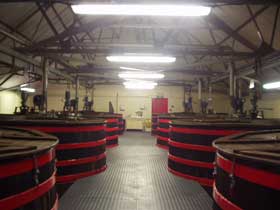
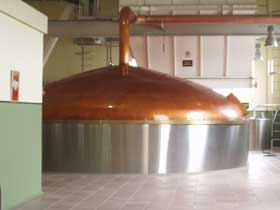
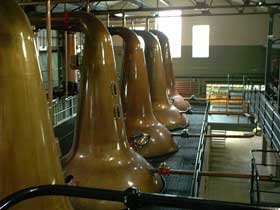 temperature
within the wash still and gradually, the fermented liquid is heated and
the alcohol in the wash vaporises. The vapours rise up the swan neck
and pass over the head of the still, before being guided through
condensers where they revert to liquid. This liquid is
collected in a receiver before being passed into the second low-wines
or spirit still where the process is repeated. The stillman exercises
much more control in the second distillation as only the heart, or
"middle cut", of the spirit flow will be collected as new spirit. This
takes place as the spirit flows through a spirit safe, where the
stillman can observe, assess and measure it.The first runnings from the
still (foreshots) and tails (feints) are returned for redistillation
with the next batch of low wines. The "middle cut" is collected by the
stillman, only when he is personally satisfied that it has reached a
high enough standard.
temperature
within the wash still and gradually, the fermented liquid is heated and
the alcohol in the wash vaporises. The vapours rise up the swan neck
and pass over the head of the still, before being guided through
condensers where they revert to liquid. This liquid is
collected in a receiver before being passed into the second low-wines
or spirit still where the process is repeated. The stillman exercises
much more control in the second distillation as only the heart, or
"middle cut", of the spirit flow will be collected as new spirit. This
takes place as the spirit flows through a spirit safe, where the
stillman can observe, assess and measure it.The first runnings from the
still (foreshots) and tails (feints) are returned for redistillation
with the next batch of low wines. The "middle cut" is collected by the
stillman, only when he is personally satisfied that it has reached a
high enough standard. Scotch
Whisky matures for much longer - from five to fifteen, twenty, or
twenty-five years and sometimes longer. It is this lingering period
during which Scotlandís cool, clean air steals through the porous oak
of the casks and charms their contents, contributing further to the
smooth and golden character of each distilleryís unique
creation. A proportion of the whisky in each cask evaporates
annually and is lost to the heavens. This is known as the "angelsí
share". Over the 12 year maturing of the Cardhu this amounts to
approximately 25%.
Scotch
Whisky matures for much longer - from five to fifteen, twenty, or
twenty-five years and sometimes longer. It is this lingering period
during which Scotlandís cool, clean air steals through the porous oak
of the casks and charms their contents, contributing further to the
smooth and golden character of each distilleryís unique
creation. A proportion of the whisky in each cask evaporates
annually and is lost to the heavens. This is known as the "angelsí
share". Over the 12 year maturing of the Cardhu this amounts to
approximately 25%.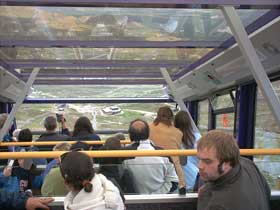 mention is that they are
from the car park and not from the top. To be fair it does say on the
back of the ticket that there is no access to the hill from the top but
how many people read the back of tickets. They also announce it on the
train when youíre well under way but by then itís too late if there has
been a genuine misunderstanding and on our trip I saw one or two
shocked faces. A few large notices by the ticket office wouldnít go
astray. So itís important that you realise your paying for a ride to
close to the top of Cairn Gorm with the possibility of a stunning view
when you get there. I say possibility because at 1097m there is every
chance that the cloud will be low enough to obscure the view. That said
you must then judge for your self weather the cost of £7.50 for adults
and £5.00 for children is value for money. There is a family ticket
available which costs £25.00 and cover 2 adults and two children which
remarkably adds up to the same price as if the tickets were purchased
singly. The benefit is that a third child can travel free. This is a
racket that is gaining in popularity.
mention is that they are
from the car park and not from the top. To be fair it does say on the
back of the ticket that there is no access to the hill from the top but
how many people read the back of tickets. They also announce it on the
train when youíre well under way but by then itís too late if there has
been a genuine misunderstanding and on our trip I saw one or two
shocked faces. A few large notices by the ticket office wouldnít go
astray. So itís important that you realise your paying for a ride to
close to the top of Cairn Gorm with the possibility of a stunning view
when you get there. I say possibility because at 1097m there is every
chance that the cloud will be low enough to obscure the view. That said
you must then judge for your self weather the cost of £7.50 for adults
and £5.00 for children is value for money. There is a family ticket
available which costs £25.00 and cover 2 adults and two children which
remarkably adds up to the same price as if the tickets were purchased
singly. The benefit is that a third child can travel free. This is a
racket that is gaining in popularity. 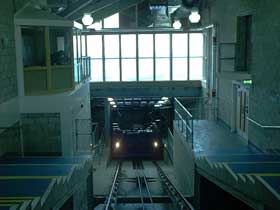 the aforementioned tunnel
at Britainís Highest underground [or over ground come to that] station.
Which serves the Ptarmigan centre. You can see the thinking behind this
building: weíve got all these punters up here what are we going to do
with them? Iíve got it lets build a interruptive centre, a tat shop and
a cafť.
the aforementioned tunnel
at Britainís Highest underground [or over ground come to that] station.
Which serves the Ptarmigan centre. You can see the thinking behind this
building: weíve got all these punters up here what are we going to do
with them? Iíve got it lets build a interruptive centre, a tat shop and
a cafť.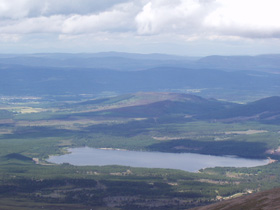 geology
and climate exhibits thereís even a nice comparative exhibit on ski
equipment that they might have used in the twenties compared to today.
But when it comes right down to it thereís not enough to get your teeth
in to. Something you certainly canít say about the Cafť with its
excellent views. Here there is lots to get your teeth in to the trouble
is everyone is queuing for the soup. The reason for this is probably
because we fully expect to be ripped off in places like this and the
soup is the only thing which anyone can see the price of. Having said
that as these places go it doesnít to bad in the price
stakes. If the views from the cafť are great then from
outside on the terrace itís something else again. Absolutely stunning
itís seriously good and then some believe me.
geology
and climate exhibits thereís even a nice comparative exhibit on ski
equipment that they might have used in the twenties compared to today.
But when it comes right down to it thereís not enough to get your teeth
in to. Something you certainly canít say about the Cafť with its
excellent views. Here there is lots to get your teeth in to the trouble
is everyone is queuing for the soup. The reason for this is probably
because we fully expect to be ripped off in places like this and the
soup is the only thing which anyone can see the price of. Having said
that as these places go it doesnít to bad in the price
stakes. If the views from the cafť are great then from
outside on the terrace itís something else again. Absolutely stunning
itís seriously good and then some believe me. 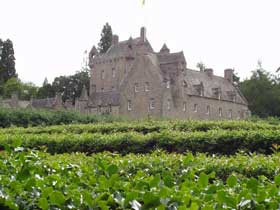 Princes
generals. Nearby is
Princes
generals. Nearby is 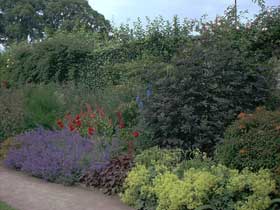 usual
cafť and tat shop and again some world class tat is in evidence. There
are extensive well maintained gardens and a large holly maze. Be warned
this is not open to the public as holly roots are not very robust.
There are also several walks and a nine hole golf course. Admission is
£6.10 for adults and £3.30 for children a family ticket will set you
back £18.00 but you do get up to five children included in that price.
Sorry there are no photographs of the interior but they go for the no
photographs rule here. I can understand the banning of flash
photography but non flash do me a favour and grow up. The way I see it
if my family are going fork out £18.00 to keep your family and its home
afloat then a few photos should be part of the deal.
usual
cafť and tat shop and again some world class tat is in evidence. There
are extensive well maintained gardens and a large holly maze. Be warned
this is not open to the public as holly roots are not very robust.
There are also several walks and a nine hole golf course. Admission is
£6.10 for adults and £3.30 for children a family ticket will set you
back £18.00 but you do get up to five children included in that price.
Sorry there are no photographs of the interior but they go for the no
photographs rule here. I can understand the banning of flash
photography but non flash do me a favour and grow up. The way I see it
if my family are going fork out £18.00 to keep your family and its home
afloat then a few photos should be part of the deal.